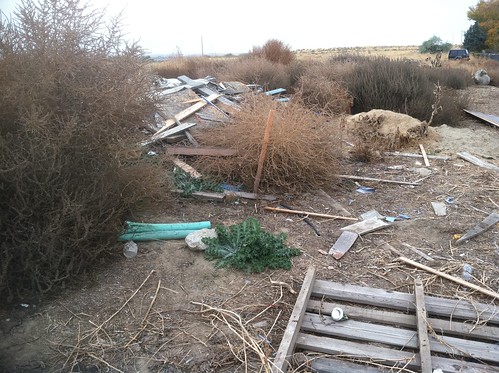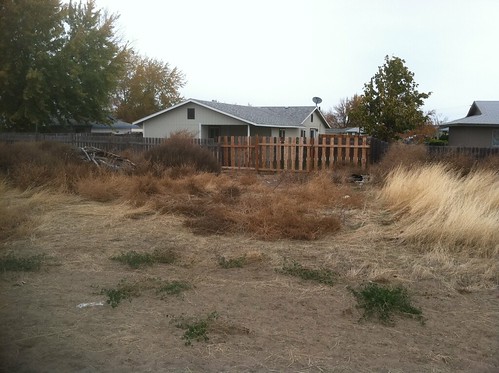
Area behind my back fence. I don't think there's a single native plant visible in this picture. Maybe in the far distance some of those trees are cottonwoods or aspen or something. (The trash-looking substance in the lower left part of this photo is cardboard I put down as temporarily mulch to keep the worst of the weeds at bay).
The vacant field behind my house is a veritable who's who of invasive non-native plants of Eastern Oregon. As someone who worked in an invasive weed eradication program, it makes me twitch every time I look at it.
Bull thistle - not too bad as far as non-natives go. Edible by quite a few different species of bugs and vertibrates. They can take over in areas, but often you see just a few at a time.
Yellow star thistle - Terrible. Has taken over huge swaths of prairie all thrughout the western US. Out competes native plants but doesn't provide forage. Not to mention, painful to hike through.
Puncturevine - Even more terrible for hiking, but not as bad overall. Creates "goat head" seeds which should be called "calthrop seeds". Punctures bike tires, dog paws, and go straight through sandals.
Downy brome aka cheat grass - "Cheats" other grasses by growing fastest and seeding out fastest, then dying and becoming a fire hazard all while not providing good graze for any animal, domestic or wild. This is a famous weed because it has caused so much damage. The seeds are, like other species of grass, "fox tails" that are barbed and once inside dog toes, ears, eyes, noses, throats, vaginas (yes), only move one way and often only possible to remove by minor surgery.
Goatgrass(?)- Interestingly, in this particular field, downy brome is not the dominant invasive grass. That dubious honor goes to this spikey grass which I'm having trouble identifying, but I think is a type of goatgrass. Confusingly, a lot of locals also call it cheat grass. It is taller than downy brome, with stiffer, spikier seedheads that, when dry, pop off the plant and can fly several feet (like directly down my dog's ear canal).
Medusahead rye - Another invasive grass that also has "fox tail" seed heads that like to get stuck in dog ears.
Diffuse knapweed - Same story, takes over, out-competes, steals moisture, not good to eat, fire hazard in later summer. (notice a pattern?)
Russian knapweed - Same story as above.
White top - Same story as above.
Skeleton weed - Not as bad as some others, but farmers hate it.
Russian thistle (aka Tumbleweed) - Made famous by every single western movie ever made. Although not quite as aggressive as some of the others listed here, it's hated by ranchers and business owners alike. It invades crops while alive, and piles up against fences and barns (and my back yard) when dead.
Kochia - A personal nemesis. Near my fence where there's water seepage from my sprinklers, it grows up to 8 feet tall and out-competes everything, including all other weeds. It also smells funny when you walk through it and bruise foliage.
There are a few others I haven't identified yet. That's the main list.
My goal for 2014 is to mulch the area directly behind my fence and plant some natives. Just off the top of my head, I'd like to see some sage, rabbit brush, lupine, some native grasses and misc. flowers. The area is about 24 x 18 yards, so it's large enough that the natives could become established and keep out the invasives with minimal management.
The city doesn't care if you do anything on the strip next to your fence as long as there's no fire hazard. Hence most of our neighbors dump garbage back there.
This is what it looked like when we moved in:


Standing on the dirt road/firebreak looking at all the lovely tall shrubby weeds.
This spring (before I got too pregnant to be useful for anything) we took two pickup loads to the dump. The spring before that I started removing the larger clumps of established shrubby weeds. This summer I've been laying down cardboard to start the mulching process. I now have a source of free wood chips, and may be getting the first delivery next week. (I really need to buy a wheel barrow). Slow and steady, right?

No comments:
Post a Comment